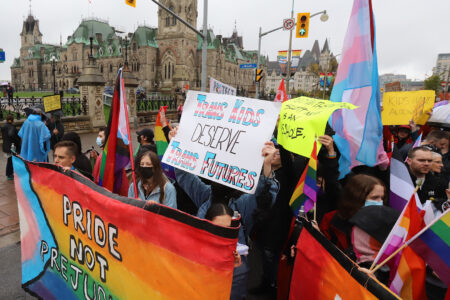
In a blog post yesterday, Professor Vanessa MacDonnell issued a scathing commentary on the majority decision in Kokopenace. One passage, in particular, stands out:
Judges wield enormous power in determining what constitutional rights require of government, and whose interests they protect. By concluding that the right to trial by jury should not be viewed as ”œa mechanism for repairing the damaged relationship between particular societal groups and our criminal justice system more generally,” the Court gives its institutional stamp of approval to the continued marginalization of Aboriginal people. As Deputy Grand Chief Alvin Fiddler of the Nishnawbe Aski Nation put it in an interview with the CBC, ”œIt’s our community members that are filling those jails. It’s our community members that are interacting with the police, and yet in terms of being part of the justice system, they’re not there.” It is an all-too familiar narrative in a country scarred by the impact of colonialism and injustice. We are accustomed to Aboriginal people being dispossessed.
Her blunt assessment:
Of course, constitutional law cannot fix every social problem. No one would suggest as much. But when Courts decide that issues of colonialism and race are irrelevant to constitutional analysis, they undermine the constitution and the Court’s position as a trusted institution.
I would make two observations. First, whether or not the Court’s approach undermines the constitution really does depend on what you think the constitution is and what it is supposed to achieve. Inasmuch as the constitution includes the separation of powers, it is quite possible to believe that the majority judgment in Kokopenace, far from undermining the constitution, saves it (and the courts) from falling into disrepute. And it is reasonably clear that separation-of-powers considerations informed the majority’s approach. Moldaver J. acknowledged that the right to a representative jury does more than just guarantee its impartiality; it ”œalso legitimizes the jury’s role as the ”˜conscience of the community’ and promotes public trust in the criminal justice system”. But he denied that this legitimization function required the state to take special steps to encourage particular groups to participate in the jury system. Indeed, the majority explicitly rejected Karakatsanis J.’s ”œfunctional approach” to s. 11(f), essentially on the basis that such a test would be difficult to apply in practice and would ”œhold the state accountable for factors outside its control.”
That might seem rather odd: If the right to a representative jury exists to ensure the legitimacy of the jury system, and jury rolls are compiled in such a way that they fail to legitimize the system, the obvious conclusion would seem to be that the right has been infringed. So why did the majority reject that conclusion? It proceeds on the basis that the test for constitutionality could not be so open-ended as to permit the courts to effectively legislate from the bench, nor blur into irrelevance the state action requirement in s. 32 of the Charter. A test that appeals directly to the rather hazy idea of ”œlegitimacy” – that asks courts to decide, on a case-by-case basis, what a ”œlegitimate” jury looks like – does not give the s. 11(f) right sufficient content to serve as a legal test. Better to devise a proxy test that is more mechanical; that does not rely to the same extent on fuzzy value judgments. That proxy test will necessarily be under-inclusive: on some occasions, it will fail to ”˜catch’ instances where jury rolls are insufficiently representative to guarantee the legitimacy of the system. At the same time, it will ensure that courts do not tread too much on the toes of other branches of government.
Maybe it’s a stretch, but I think we can see separation-of-powers concerns arising in a second sense. The majority treats the rights in issue in ss. 11(d) and 11(f) as rights personal to the accused as a criminal defendant. We are talking, here, about his right to a fair trial; his right to a representative jury. We are not talking about the Aboriginal community’s right to be adequately represented on juries, or his right as an Aboriginal person to a particular jury composition. This makes all the difference in the world. Just take a look at the majority’s opening paragraph:
[I]t must be remembered that the right to a representative jury is an entitlement held by the accused that promotes the fairness of his or her trial, in appearance and in reality. It is not a mechanism for repairing the damaged relationship between particular societal groups and our criminal justice system more generally ”” and it should not be tasked with that responsibility.
And here:
The Iacobucci Report concludes, at para. 209, that ”œthe most significant systemic barrier to the participation of First Nations peoples in the jury system in Ontario is the negative role the criminal justice system has played in their lives, culture, values, and laws throughout history”. This is a serious policy concern that merits attention. But the accused’s ss. 11(d) and 11(f) Charter rights are not the appropriate vehicle to redress this concern. The accused’s right to be tried by a jury of his peers is a right aimed at securing a fair adjudicative process. It cannot be used to dictate to the government how it should – let alone must ”” resolve important policy questions of this nature. For the purposes of ss. 11(d) and 11(f), the state’s constitutional obligation stops when it has provided a fair opportunity for a broad cross-section of society to participate in the jury process. It has done so.
In the end, says the majority, the issue is whether this trial is fair, not whether the criminal justice system is fair.
So where is the separation-of-powers issue? Technically, the majority is basing its argument on the content of ss. 11(d) and 11(f). But realistically, this is an argument about the accused’s standing – albeit as a criminal defendant – to make certain kinds of Charter claims. It reflects a traditional narrow idea of what a criminal trial is about. As an individual abstract defendant, the accused clearly has standing to raise matters that go to the state’s authority to try him – he has standing, for example, to challenge the basis on which he was detained, or on which evidence was seized. But it is by no means obvious that he has standing to object to the manner in which the state interacts with an entire community. Indeed, the majority found that the accused lacked standing under s. 15 for precisely this reason: his interests as a criminal defendant do not necessarily align with the interests of Aboriginal on-reserve residents who might potentially serve as jurors.
I’m still test-driving that idea, and no one is required to buy into it. But if we see this as a quasi-standing argument, we can again see the separation-of-powers doctrine at work in Kokopenace. Arguments about standing are really arguments about whether the relationship between a prospective litigant and a legal question is sufficiently tight to say that there is a live case or controversy before a given court, such that it has jurisdiction to settle it. We saw Moldaver J. wrestling with a similar problem in Nur, in which he argued that stringent limits should be placed on the reasonable hypothetical branch of the s. 12 Charter inquiry. Just as in Moldaver J.’s opinion in Nur, the Kokopenace majority’s concern is that a criminal defendant may use a trial that is fundamentally about his guilt or innocence – or about the state’s treatment of him – to raise insufficiently connected controversies.
My second observation is this: The Supreme Court has long been reluctant to apply rigorous Charter scrutiny to structural aspects of the criminal justice system. In particular, Crown prosecutors operate with little meaningful judicial oversight. This reflects, as the Court has itself observed, the need for administrative efficiency in that context, as well as the separation of powers. We saw a similar concern at work in Kokopenace. Any legal test that permits judges to engage in a free-ranging inquiry into the fairness of the criminal justice system generally, as a precondition to trying any particular criminal defendant, would arguably over-burden the system. Sections 11(d) and 11(f), Moldaver J. claimed, could not require such massive upheaval. He remarks:
[B]efore long, the jury selection process would become a public inquiry into the historical and cultural wrongs and damaged relationships between particular societal groups and our criminal justice system and the failings of the state to take adequate steps to address them. In turn, this would make it virtually impossible to have a jury trial anywhere in this country ”” and the administration of criminal justice would suffer a devastating blow.
One could reply that this has a perverse implication: the very fact that Aboriginal people have been grossly over-represented in the criminal justice system is a reason not to allow them to use the legal rights provisions in the Charter to effect large-scale changes to it. Changes must be on a smaller scale to be workable. This certainly causes us to see decisions like Williams in a somewhat different (and disappointing) light. That was a decision in which the Supreme Court of Canada recognized a defendant’s right to challenge prospective jurors for cause on the basis of widespread racial bias against Aboriginal people. But, Moldaver J. suggests, it was only a minor change to the then-existing laws governing the empanelling of jurors. Had it been more significant, he hinted, the Court might well have been unwilling to decide Williams as it did.
*
Does all this undermine the constitution? I’m not so sure. It certainly doesn’t reflect an especially inspiring vision of the Charter as a vehicle for systemic social change. But not all of us are so confident that that’s what constitutions – even bills of rights – are primarily for. At bottom, a constitution is still a legal instrument. The aspirational tone and open-endedness of its language often mean that debates over their meaning can occasionally resemble those which take place in the political sphere. (Though at its best, these debates look less like Power and Politics, and more like a seminar on Rawls’ Political Liberalism.) But in the end, the concerns that preoccupy us elsewhere in law – certainty, stability, predictability – are just as present in constitutional law. One does not need to be a MacDonald-Laurier Fellow to think so.
MacDonnell knows this. As she says, not everything can be resolved with constitutional litigation. On the best reading of her comments, systemic racism against Aboriginal peoples is so patently obvious (true), and so plainly damaging to the credibility of the legal order (also true), that courts must be able to take account of it when giving content to constitutional rights. If not this, she seems to say, then what?
It’s a plausible enough view. But one could just as easily argue that the most important and problematic issues should be settled through politics. Indeed, the case that has done the most to bring systemic racism against Aboriginal people in the criminal context to the attention of judges and lawyers is almost certainly Gladue – a non-Charter ruling that interpreted a sentencing provision in the Criminal Code. Gladue has not yet had the impact that many would like, but it is important. And it was ordinary politics that made it possible.
*
If all this sounds like a heavily qualified defense of Kokopenace, that’s because it is. My point is not, ultimately, to say that Moldaver J. got it right – just to say that this is all part of the usual ebb and flow of constitutional interpretation. For those with high ambitions for the Charter, Kokopenace will be disappointing. The bedrock constitutional premises on which the decision was reached, however, are not new.
Update: I will be posting a reply by Professor MacDonnell in the next couple of days. Stay tuned!
Update: Here is Professor MacDonnell’s reply in full:
I am grateful to Michael Plaxton for responding to my blog entry, and for offering to post this rejoinder at the end of his piece.
Because subsections 11(d) and (f) of the Canadian Charter of Rights and Freedoms impose affirmative obligations on the state (thank you to Leo Russomanno for reminding me of this), the operative question is not whether the state must ”œtake special steps to encourage particular groups to participate in the jury system,” but what steps it is required to take to ensure that it fulfils its constitutional obligations. I agree with the dissent that an accused’s constitutional rights are infringed when the state’s efforts do not produce a jury roll that ”œsubstantially resembles” the community. In other words, the state’s efforts must be effective.
I am not persuaded that carving out a workable test for representativeness is an insurmountable challenge. The dissenters propose what seems to me to be a reasonable test at para 226:
A representative jury roll is one that substantially resembles the group of persons that would be assembled through a process of random selection of all eligible jurors in the relevant community. A petit jury is representative if it is properly selected from that roll. But random selection is only a good proxy for representativeness if the pool of persons to whom a process of random selection is applied to assemble the jury roll is itself broadly based within the relevant community.
The dissent’s proposed test would not permit ”œa free-ranging inquiry into the fairness of the criminal justice system generally,” as Plaxton implies. The inquiry they suggest is no more onerous – and probably less – than the one for race-based challenges for cause.
I agree with Plaxton that it would be inappropriate for judges to conduct an ”œopen-ended” inquiry into the jury’s ”œlegitimacy” in response to claims that a jury roll is not representative. But that was not the point I was making in my July 1st blog entry. My point (echoing that of the dissenters in Kokopenace) was simply that juries must be representative for their verdicts to be legitimate.
Plaxton raises the spectre of separation of powers issues in his post. I disagree that this case presents separation of powers concerns. The evidence amply demonstrated that the jury roll was deficient in its representation of Indigenous people and that this was a longstanding problem. While it is true that the Ontario government commissioned a study to investigate the problem and has begun to implement the Report’s recommendations, the political process has not produced much in the way of concrete results to this point. This makes Kokopenace a fairly classic case for judicial intervention (see my work here on appropriate standards for judicial intervention in the context of positive rights, drawing on German and South African law). Moreover, courts are uniquely placed to deal with these kinds of administration of justice issues (Phillip Bryden has written on this here).
Finally, I tried to be clear in my blog post that this particular accused’s Charter rights were violated by not having a representative jury roll. I would need to think more about the possibility of representativeness claims being brought by Indigenous people from the catchment area or by the accused on behalf of those individuals. This would be interesting to examine in light of the US jurisprudence, which treats peremptory challenges exercised on the basis of race as infringements of both the accused’s and the potential juror’s rights.







